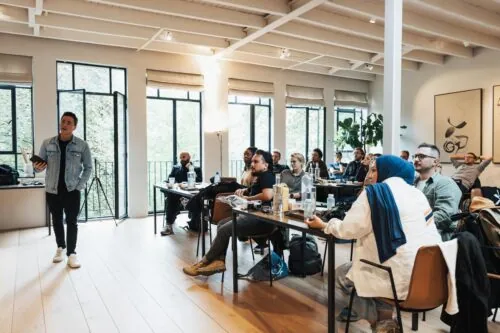Welcome to the world of work, where the only constant is change. If you’re stepping into the workplace for the first time, you’re joining a tapestry of talents spanning generations. It’s a place where Baby Boomers work alongside Gen Z and where Millennials share ideas with Gen Xers. This diversity isn’t just about age—it’s about the rich exchange of experiences, perspectives, and skills that define our times of multigenerational workforce challenges.
Understanding and navigating multigenerational workforce challenges can seem daunting. But fear not. This guide is designed to demystify the dynamics of today’s workforce for entry-level job seekers like you. We’ll explore the unique traits of each generation, the challenges and opportunities they bring, and how to thrive in a diverse workplace.
Every generation has its strengths and lessons to share. By embracing diversity and learning to collaborate across age groups, you’ll accelerate your career growth and contribute to a more inclusive and productive workplace.
So, are you ready to embark on this journey? Let’s understand the multigenerational workforce and unlock the door to your successful career path.
Understanding Generational Diversity in the Workplace
Today’s workforce is more mixed than ever. Four generations—Baby Boomers, Generation X, Millennials, and Generation Z—work side by side. Each group has its view of the world, shaped by unique experiences. So, what’s behind multigenerational workforce challenges? It’s about recognizing these differences and using them to our advantage.
First, it’s vital to grasp that each generation brings something unique. For instance:
- Baby Boomers provide years of experience and a strong work ethic.
- Generation X offers a blend of independence and tech-savvy.
- Millennials are known for their teamwork and desire for meaningful work.
- Generation Z brings an innate understanding of digital tools and a fresh perspective.
Thus, generational diversity in the workplace is not just a fact of life—it’s a valuable asset. By maximizing each group’s strengths, companies can innovate, solve problems more effectively, and better connect with a diverse customer base. Moreover, fostering a culture of inclusion can help attract and retain the best talent across all age groups.
Still, navigating this diversity comes with challenges. These include overcoming stereotypes, finding the right balance of communication styles, and creating opportunities that meet the expectations of each generation.
For more insights on this topic, check out resources like the Society for Human Resource Management (SHRM) or Forbes for expert articles and tips on managing a multigenerational workforce.
The Four Generations at Work
In today’s diverse workplace, understanding each generation’s background is critical. Let’s dive into who they are and what they bring.
Baby Boomers: The Loyal Workforce
Born between 1946 and 1964, Boomers have seen a lot of change. They value stability and are known for their loyalty. With deep knowledge and experience, they’re the backbone of many companies.
Generation X: The Independent Innovators
Those born between 1965 and 1979 make up Gen X. They grew up in a time of significant change, leading to a strong sense of independence. They value work-life balance and are adept at using technology to improve productivity.
Millennials: The Purpose-Driven Team Players
Millennials, born between 1980 and 1994, seek purpose in their work. They favor jobs that offer growth and social impact. As digital natives, they’re comfortable with technology and value collaboration.
Generation Z: The Digital Natives
Gen Z, born after 1995, is the newest to enter the multigenerational workforce and are true digital natives. They expect tech-savvy workplaces and look for innovation and creativity in their roles. Fast learners crave feedback and rapid career progression.
The key to success? Learning how to harness the strengths of each generation. By doing so, companies can create a powerhouse team ready to tackle any challenge. For detailed strategies for managing diverse teams, websites like the Harvard Business Review offer excellent insights and tips.
Benefits of Multigenerational Workforce Challenges
Mixing generations at work has many upsides. It’s not just about making the team look diverse. It’s about getting real value from different views and skills.
Boosting Innovation
With varied perspectives, teams can think outside the box. Older generations offer wisdom, while younger ones bring fresh ideas. Together, they spark innovation.
Enhanced Problem-Solving
Diverse teams can tackle challenges from many angles. This approach often leads to more innovative, more effective solutions.
Better Understanding of Customers
A multigenerational workforce mirrors a diverse customer base. Thus, these teams can better predict and meet customer needs.
Also, diverse teams help each other grow. Younger workers can learn from the experience of older colleagues. Similarly, older employees can pick up new tech skills from younger ones. So, everyone benefits and grows together.
This positive atmosphere often leads to higher job satisfaction. And, as we all know, happy workers are critical to a successful business. By embracing multigenerational workforce challenges, companies can boost morale and retain top talent across all age groups.
Having varied age groups can lead to more stability during changes. For example, while younger workers can quickly adapt to new tech, older employees can provide continuity and calm during transitions. This balance makes the entire team more resilient.
The benefits of a diverse age range at work are clear. Next, let’s look at the challenges and how to overcome them.
Challenges and How to Overcome Them
While diverse teams bring many benefits, they can also face hurdles. But, with the right approach, these challenges can be managed effectively.
Communication Gaps
Different generations often have unique ways of communicating. For example, Boomers might prefer face-to-face meetings, while Gen Z may lean towards digital messages. Companies can offer training on various communication tools to bridge multigenerational workforce challenges and encourage employees to share their preferences.
Varied Work Ethics and Values
What one generation sees as hard work, another might view as overdoing it. Creating a space where everyone’s work style is respected is crucial. Regular team-building activities can help by fostering understanding and respect among diverse team members.
Resistance to Change
Change can be daunting, and reactions can vary widely across generations. Some may embrace it; others could resist. Open dialogue about changes and involving all generations in decision-making can ease these transitions.
To address these multigenerational workforce challenges head-on, developing customized management strategies for each generation can be highly effective. Specialized training programs can equip managers to handle generational diversity better. For insights and tips on tailoring these strategies, resources like managing generational differences can be invaluable. Employers can create a more harmonious and productive workplace by acknowledging and addressing these unique needs.
Appreciating and leveraging the strengths of each generation can transform potential obstacles into opportunities for growth. For instance, pairing younger workers with older mentors can facilitate knowledge transfer, benefiting both individuals and the organization.
The following section will explore strategies for harmonizing these multigenerational workforce challenges, turning challenges into a cohesive force driving the company forward.
Strategies for Harmonizing Generational Differences
Turning the challenges of a multigenerational workforce into strengths requires action. Here’s how to make the most of a diversified team.
Fostering Open Communication
Openness is key. Encourage the sharing of ideas and concerns. Hold regular meetings where all generations can voice their thoughts. And, importantly, listen.
Tailoring Management Styles
One size doesn’t fit all. Adapting your approach based on age groups can lead to better engagement. For example, Millennials might thrive on frequent feedback, but Gen Xers prefer more autonomy.
Embracing Flexible Work Arrangements
Flexibility is a win-win. It addresses the varying needs across generations, promoting work-life balance and job satisfaction. For insights on creating such arrangements, check out flexible work arrangements.
Beyond these strategies, offering professional development opportunities tailored to different career stages can be extremely rewarding. It helps personal growth and ensures all team members feel valued and invested. LinkedIn Learning and Coursera offer courses catering to different interests and learning styles.
With these methods, companies can minimize friction among different generations and enhance cooperation and productivity. Next, let’s explore how to turn these strategies into real-life advantages.
Turning Challenges into Opportunities
When it comes to multigenerational workforce challenges, every challenge hides an opportunity. It’s about perspective and action.
Creating a Culture of Mentorship
Pairing seasoned pros with newcomers can boost skills across the board. This mentorship benefits both parties, fostering a culture of lifelong learning.
Leveraging Diverse Perspectives for Innovation
Different generations bring different viewpoints. By blending these, companies can innovate more effectively and stand out in their markets.
Improving Client Relationships
Multigenerational teams can better understand and connect with clients of all ages. This understanding can lead to stronger client relationships and new market opportunities.
Embracing generational differences strengthens team bonds. It highlights the value of each member, making the team feel more inclusive. This unity improves work life and aligns everyone towards common goals.
A workplace keen on balancing multigenerational workplace dynamics signals to potential employees that it values diversity and inclusion. This appeal can attract top talent from all ages, further enriching the organization’s talent pool.
By seeing past stereotypes and focusing on strengths, businesses can transform generational diversity from a potential source of conflict into a strategic advantage. Understanding and leveraging these dynamics will be crucial for any team’s success as we move forward.
FAQ’s
What Makes a Workplace Truly Inclusive?
A genuinely inclusive workplace is where everyone feels valued and heard. It’s a place where differences are celebrated and opportunities are equal.
How Can Younger and Older Generations Benefit from Each Other?
Younger workers can gain wisdom and guidance, while older employees can learn new technologies and approaches. It’s a win-win.
What Are the Signs of Generational Conflict at Work?
Signs include frequent misunderstandings, reluctance to collaborate, and a lack of respect for different work styles.
How Can We Promote Generational Understanding?
Encourage mentorship programs, host team-building activities, and provide training on the value of diversity.
Is It Possible to Have Too Much Diversity in a Team?
No. Diversity, in all forms, brings enriching perspectives and strengthens problem-solving. The key is effective management.
The diversity of a multigenerational team is about more than overcoming challenges; it’s about unlocking potential. As we recognize and celebrate each other’s strengths, we create a more productive workplace and a more harmonious world.
Conclusion
We’ve explored a multigenerational workplace’s landscape, uncovering its challenges and infinite possibilities. This journey has shown us that generational diversity is not just a trend but a powerful tool for innovation, empathy, and growth.
However, embracing this diversity fully requires action. It begins with understanding each generation’s unique perspective and then moving forward with strategies that honor these differences. It’s about creating diversity and inclusion jobs where everyone feels valued and empowered regardless of age.
Are you ready to be part of this change? We invite you to join Diversity Employment, where embracing diversity isn’t just a goal – it’s a reality. Let’s build a future where every generation’s contributions are celebrated, and everyone’s potential is unlocked.




